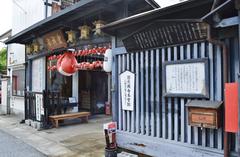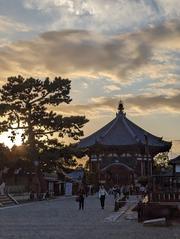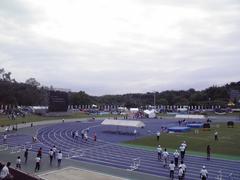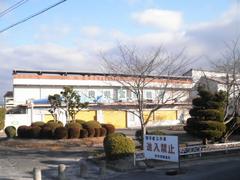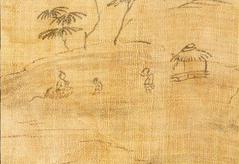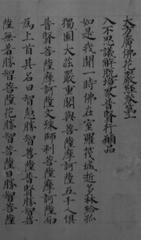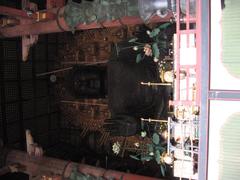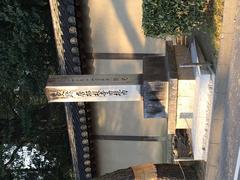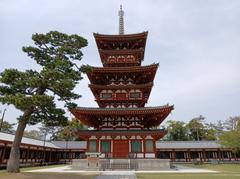
Isagawa Shrine Visiting Hours, Tickets & Nara Historical Sites Guide
Date: 04/07/2025
Introduction
Isagawa Shrine (率川神社, Isagawa-jinja) stands as one of Nara’s most ancient and culturally significant Shinto shrines, offering visitors a unique gateway into Japan’s spiritual heritage. Established as early as the 6th or 8th century, the shrine is dedicated to Empress Himetataraisuzuhime no Mikoto, symbolizing family harmony, protection, and fertility. Renowned for its annual Lily Festival (Saikusa Matsuri) and tranquil traditional grounds, Isagawa Shrine serves as both a historical monument and a living center of community rituals (Yamatoji Nara Kankou, Isagawa Shrine Official Site, NAVITIME Japan, Kansai Scene).
This guide provides comprehensive details on Isagawa Shrine’s history, religious importance, visiting hours, accessibility, etiquette, festival highlights, and recommended nearby attractions, ensuring you make the most of your visit to Nara’s rich cultural landscape.
History and Cultural Significance
Origins and Foundation
Isagawa Shrine is believed to have originated during the early Nara period, with its name derived from the nearby Isagawa River, an important spiritual landmark. The shrine’s foundation reflects the early syncretism of Shinto and Buddhist practices, established to protect and spiritually serve the local community (Yamatoji Nara Kankou).
Enshrined Deities
The principal deity is Himetataraisuzuhime no Mikoto, consort of Emperor Jimmu and a symbol of familial blessings. Unique to Isagawa Shrine, she is worshipped together with her parents, Sai no Okami and Tamakushihime no Mikoto, reinforcing the shrine’s focus on family unity and health. Worshippers commonly pray here for safe childbirth, marital harmony, and overall well-being.
Architectural Features
Isagawa Shrine exemplifies classical Shinto architecture, featuring a honden (main hall) and haiden (worship hall) crafted from native Japanese cypress. The grounds include stone lanterns, serene torii gates, and sacred trees—elements that have been maintained through careful restoration. The simplicity of the structures emphasizes harmony with nature (NAVITIME Japan).
Major Festivals and Rituals
Lily Festival (Saikusa Matsuri)
Held annually on June 17th, the Lily Festival is the shrine’s signature event, with origins tracing back to 701 CE. The festival features ritual sake offerings—one barrel of white sake and one of black—adorned with lilies, symbolizing prayers for protection against disease and disaster. Sacred dances by miko (shrine maidens) and ceremonial processions connect the ritual to ancient legends surrounding Empress Himetataraisuzuhime no Mikoto (Isagawa Shrine Official Site).
Other Annual Events
Isagawa Shrine also observes New Year’s rituals, the Goshinka Festival on January 1st, and the First Ebisu on January 5th, all of which reinforce its role in safeguarding community prosperity and health.
Visiting Information
Hours
- General Opening: 6:00 AM – 5:00 PM (hours may vary seasonally and during festivals)
- Lily Festival (June 17): Main ceremony begins at 10:30 AM
Check the official website for updates.
Tickets and Admission
- Admission: Free for all visitors
- Festival Attendance: No tickets required. Arrive early for good viewing spots.
Location and Access
- Address: 18 Honkomoricho, Nara City
- By Train: 5–10 minutes’ walk from Kintetsu Nara Station, 15–20 minutes from JR Nara Station
- By Bus: Local buses stop nearby (Visit Nara)
Accessibility
The shrine grounds are mostly flat and paved, offering reasonable accessibility for visitors with mobility challenges. Some areas may have steps or uneven surfaces; contact the shrine in advance for assistance.
Cultural Etiquette and Photography
- Purify hands and mouth at the temizuya (water basin) before entering
- Bow twice, clap twice, bow once when making offerings at the main hall
- Photography is allowed outdoors; refrain from using flash or photographing inside the main hall or during rituals unless permitted
- Remain quiet and respectful, especially during ceremonies
Facilities
- Restrooms: Not on the shrine grounds, but available nearby in Nara Park or train stations
- Shops: Purchase omamori (amulets) and ema (prayer plaques) at the shrine office
- Language: Some English signage; staff are accustomed to international visitors
Best Times to Visit
- Time of Day: Early morning (6:00–8:00 AM) or late afternoon (3:00–5:00 PM) for tranquility and optimal light (Traveler Bibles)
- Seasons: Spring (March–May) for cherry blossoms; autumn (September–November) for colorful foliage (Odynovo Tours)
Nearby Attractions
Enhance your Nara experience by visiting these sites nearby:
- Kōfuku-ji Temple: UNESCO World Heritage Site with a five-storied pagoda
- Sarusawa Pond: Scenic spot for relaxation and photography
- Nara Park: Home to free-roaming sacred deer (Japanese Mythology Worldwide)
- Todai-ji Temple: Famous for the Great Buddha
- Kasuga-taisha Shrine: Renowned for its lantern-lined paths
Suggested walking route: Start at the station, visit Nakatanidou Mochi Shop, proceed to Isagawa Shrine, continue to Kōfuku-ji, stroll around Sarusawa Pond, and finish in Nara Park (Kansai Scene).
Practical Tips
- Wear comfortable shoes for walking and gravel paths
- Bring cash for offerings and souvenirs—credit cards are rarely accepted
- Dress modestly, especially during festivals or if entering sacred spaces
- For the Lily Festival, arrive early due to crowds and bring weather-appropriate gear
- Carry a translation app or phrasebook for basic Japanese communication
Festival Experience Highlights
- Witness the ceremonial procession, traditional music, and lily-adorned sake offerings during the Lily Festival
- Participate in purification rituals and offer prayers for family well-being
- Purchase omamori or ema as meaningful souvenirs and support shrine upkeep
Frequently Asked Questions (FAQ)
Q: What are the shrine’s opening hours?
A: Generally 6:00 AM to 5:00 PM; check for seasonal variations.
Q: Is admission free?
A: Yes, entry is free for all visitors.
Q: Do I need tickets for the Lily Festival?
A: No, the festival is open to all; arrive early for a good spot.
Q: Is the shrine accessible for those with disabilities?
A: Mostly, though some areas have steps or uneven ground.
Q: When is the best time to visit?
A: Early mornings, late afternoons, spring, and autumn are ideal.
Q: Can I take photos inside the shrine?
A: Photos are allowed outdoors; avoid taking pictures inside the main hall or during ceremonies.
Sustainability and Responsible Tourism
- Support the shrine by making small donations or purchasing omamori
- Dispose of trash properly and respect the natural environment
- Do not feed wildlife or damage any plants or structures
Visuals and Media
Images to be added with descriptive alt text for accessibility and SEO: “Isagawa Shrine torii gate in Nara, Japan,” “Traditional Shinto architecture at Isagawa Shrine,” and “Lily Festival procession at Isagawa Shrine.”
Conclusion
Isagawa Shrine offers a captivating blend of historical depth, cultural tradition, and tranquil beauty, making it an essential stop for any visitor to Nara. Its accessible location, welcoming atmosphere, and free admission invite both reflection and celebration—whether for a quiet morning visit or during the vibrant Lily Festival. Plan your visit to coincide with local festivals or explore in the calm of early morning for a truly memorable experience.
Stay updated on schedules, events, and travel tips by checking official sources, downloading the Audiala app, and following us on social media. Explore Nara’s other historic sites for a deeper journey into Japan’s enduring heritage.
Useful Links
- Isagawa Shrine Official Website
- Isagawa Shrine - Yamatoji Nara Kankou
- Isagawa Shrine - NAVITIME Japan
- Isagawa Shrine Official Site - Festivals & Information
- Kansai Scene: A Perfect Long Weekend in Nara
- Visit Nara: Travel Tips
- Traveler Bibles: Best Time of Day to Visit Nara
- Odynovo Tours: Nara Travel Guide
- Japanese Mythology Worldwide: The Sacred Deer of Nara
















